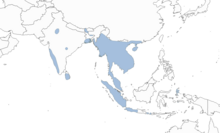Painted bat
| Painted bat | |
|---|---|
| Scientific classification | |
| Kingdom: | |
| Phylum: | |
| Class: | |
| Order: | |
| Family: | |
| Genus: | |
| Species: | K. picta
|
| Binomial name | |
| Kerivoula picta (Pallas, 1767)
| |

| |
| Species distribution (in southeast Asia) based on data from the IUCN. | |
The painted bat (Kerivoula picta) is a species of vesper bat in the family Vespertilionidae.
It is found in Brunei, China, India, Indonesia, Malaysia, Nepal, Sri Lanka, and Vietnam. It is found in arid woodland. It is known as විසිතුරු කිරිවවුලා (meaning the same as the English term) in the Sinhala language.
The body and tail are the same length. The body length is 3 to 5.5 cm. The tail length is 3 to 5.5 cm as well. The wingspan is 18–30 cm. Weight is about 5g.
Small groups of these animals are often found in the most unlikely roosts such as in the suspended nests of weaver finches and sunbirds or under the eaves of huts. Doubtless the bright and broken coloration of these bats is a form of camouflage to protect them while they roost in vulnerable sites. Although nothing is known of their reproductive habits, Painted bats have nuclear family units - that is, a mother, a father, and young. Hunting flights last around 1–2 hours.
Besides the coloring it is otherwise a fairly normal microbat that uses sonar to catch insects at night.
They live in Southern and eastern India to southern China. They are rare and live in groups of only 2–6.
Kerivoula picta is bright orange or scarlet, with black wings and orange along the fingers. As in other species of Kerivoula, K. picta possesses long, wooly, rather curly hair, a small, fragile form, large funnel-shaped ears and 38 teeth. Ears are naked. Tragus is long, narrow, and transparent. Muzzle very hairy. Older males are brighter than females.
Echolocation
Echolocation for this species is relatively similar to other species of Kerivoula. Recorded calls were broadband and steep calls ranging from 156.9 kHz to 41.5 kHz. Flight and resting echolocation calls differed every way except the peak frequency. Bats with higher starting frequencies appear to be better at catching prey close to clutter than those with lower frequencies. This is significant considering the amount of debris that is normally around their habitat.[1]
References
- ^ Sripathi, K., H. Raghuram, and N. Thiruchenthil. "Echolocation Sounds of the Painted Bat Kerivoula Picta (Vespertilionidae)." Current Science 91.9 (2006): 1145-147. Print.
- Chiroptera Specialist Group 1996. Kerivoula picta. 2006 IUCN Red List of Threatened Species. Downloaded on 19 July 2007.

